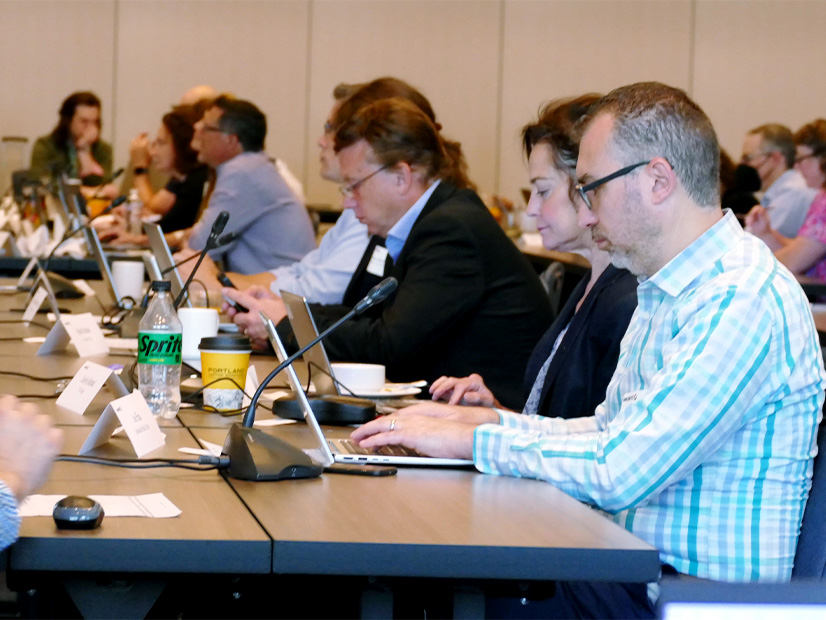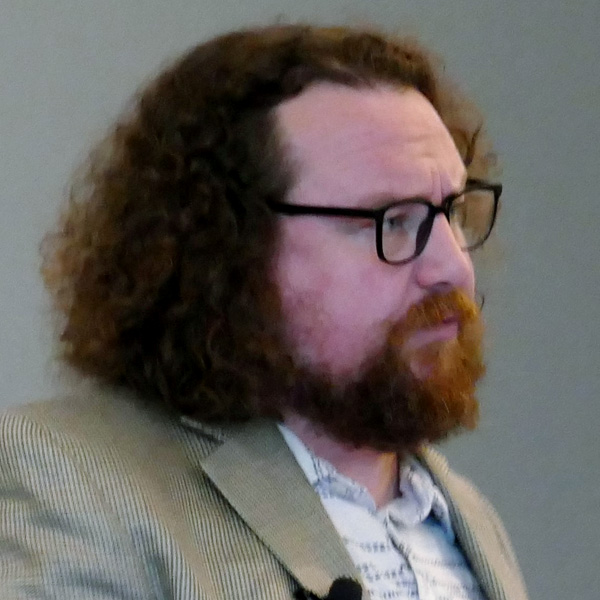
PORTLAND, Ore. — Potential SPP Markets+ participants last week endorsed the first pieces of the day-ahead market’s tariff, acquiring a taste of the grid operator’s stakeholder process at the same time.
The core of that process is a focus on reaching consensus. It is ideally driven by stakeholders with SPP staff support, with a final agreement that satisfies a solid majority of members.
SPP Director Steve Wright, who chairs the three-person Interim Markets+ Independent Panel (IMIP) responsible for the market’s development, complimented the Markets+ Participant Executive Committee (MPEC) and its working groups and task forces for quickly adapting to the stakeholder process.
“I’m really impressed with the way that you’ve embraced democracy. Democracy can be messy, and it can be hard, but that’s what we’re doing here,” Wright said during the conclusion of the MPEC’s Aug. 8-9 meeting. “We love to see the participation; the way the voting structure is working; the way that motions create clarity around what it is that’s on the table, and then being able to move forward.”
John Cupparo, who along with fellow director Liz Moore fills out the IMIP, recalled the tariff discussion led by Bonneville Power Authority’s Russ Mantifel. Standing isolated in front of the MPEC for almost an hour and a half, Mantifel described how he was able to “flex the democratic muscle” — flexing his own muscles for emphasis — during workgroup discussions and gain confidence in the recommendations and motions that came forward.
“I thought it was a very important point in terms of the confidence that it gave him and hopefully that group in terms of how the process works and what we’re building,” Cupparo said. “I’m hopeful that that confidence propagates and continues to propagate among the workgroups.”
Cupparo also noted the workgroup updates that filled the agenda included “natural” references to SPP staff and the SPP Market Monitoring Unit.
“It suggests that there’s a growing partnership, which is very important in this process, not only now but for the future,” he said.
With CAISO having about an eight-year head start in developing a Western RTO, and a group of utility commissioners from the West calling for an independent grid based on CAISO’s operating framework, that partnership could be key for SPP’s plans to offer “RTO-light” services that include day-ahead and real-time unit commitment and dispatch. (See In Contest for the West, Markets+ Gathers Momentum — and Skeptics.)
SPP plans to complete this second phase of Markets+’s development by filing a completed tariff with FERC early next year. The IMIP and MPEC are expected to sign off on the tariff language in December, with the RTO’s Board of Directors taking up a vote in January.
Wright reminded Markets+ stakeholders that once the tariff is filed, potential participants will have to decide whether to proceed with costly systems development or wait for FERC’s approval. He urged further discussion on that next step during the MPEC’s upcoming virtual and in-person meetings.
“The SPP staff needs this guidance because this is an allocation-of-resources issue. Folks have got to know what their work plans are going to look like, and so we need some sense of what the market participants are thinking,” he said. “I know there’s a bit of a chicken-and-egg issue here. It’s, ‘Well, I need to know for sure the tariff is proceeding before I’m prepared to commit dollars.’ On the other hand, if we wait until everything is final, then it will have a significant impact on the overall scheduling and the go-live date for a Markets+ market.”
MPEC Chair Laura Trolese, with The Energy Authority, said that while the program is on track, there is “some potential risk” of the schedule slipping over approval of the “boilerplate” tariff language.
“The working groups have been a little hesitant to approve boilerplate language,” she said. “There’s been quite a bit of education and level-setting and bringing everyone up to speed.”
Trolese said stakeholders have reaffirmed moving forward with the boilerplate language, with an understanding that the final tariff will include changes to accommodate issues unique to the West.
Carrie Simpson, SPP’s director of Western services development and MPEC’s staff secretary, pointed out that the boilerplate tariff language the stakeholder groups have started with is limited to principles and concepts outlined in the Markets+ service offering that participants agreed to last year.
“It’s the SPP existing market design, and the SPP market design is largely based on MISO’s market design, which is largely based on PJM’s market design. These are best practices,” she said.
IMIP Approves Virtuals’ Delay
The IMIP agreed with MPEC’s recommendation to delay the implementation of the price convergence financial product, or virtuals, by six months after the market goes live and with built-in circuit-breakers.
Virtuals are proposals to buy and/or sell energy at a settlement location for a specific time period in the day-ahead market. They were created to foster price convergence between the day-ahead and real-time markets and add liquidity. Settlements are based on the difference between the day-ahead and real-time price.
Stakeholders reasoned that virtuals, or the lack thereof, will not affect must-offer obligations. In addition, Markets+ boundary interface settlement locations are not eligible for virtuals. SPP will assess the settlement locations within a year of the virtuals becoming binding.
“My impression is that it was a rather robust conversation at the workgroup level, and it demonstrated that there’s differing points of views and there’s a way to get to a compromise or a consensus,” Cupparo told the MPEC. “That’s at the heart of what we do every day within the SPP way of life. That’s the model. That’s how it works.”
It was the only item the IMIP took up for consideration, saying it wanted to avoid interfering in the developmental work.
“There should be no sense of a signal that we have concerns about what’s going on. We’re trying to make sure that we’re not micromanaging you,” Cupparo told the MPEC.
The MPEC did endorse tariff language governing day-ahead and operating day activities, and LMPs and market clearing prices (MCPs). Committee members agreed a draft of language on scarcity pricing’s effect on LMPs and MCPs should be reviewed and brought back to the MPEC.
GHG Issue: ‘Emissions Leakage’
Clare Breidenich, who co-chairs the Markets+ Greenhouse Gas Task Force (MGHGTF), said the team is currently reviewing a draft and providing feedback on its tariff language, which is on track to be approved in October.
The task force’s primary objective is to develop a market solution, best practices, rules and protocols that support the Northwest’s only cap-and-trade program, that of Washington state, Breidenich told the MPEC.
“That program is already in place. Entities are incurring carbon obligations as of this year,” she said. “The live Markets+ would need to accommodate that program from the get-go.”
Labeled as cap-and-invest in Washington, the program began earlier this year with the Department of Ecology conducting the first two quarterly auctions. The department had to put up more than 1 million carbon allowances to help keep emitters’ costs in check after the May auction cleared at an unexpectedly high price ($56.10/allowance). (See Wash. Auctions Reserve Carbon Allowances to Relieve Price Pressure.)
Breidenich, who specializes in carbon policy, markets and regulations for the Western Power Trading Forum, said the task force is focusing on megawatt re-designation, or emissions leakage. This occurs when a change in market dispatch to accommodate the Washington program reduces emissions associated with generation serving load in the state but increases the market footprint’s emissions.
“The bulk of our work within the task force is trying to narrow down the definition of this problem to solve it,” she said.
The task force is evaluating the need for a multi-solve solution in the market-clearing engine and developing other options to minimize leakage, Breidenich said. The intention is to “identify what megawatts from what resources are eligible to be attributed to Washington state,” she said.
“Washington state is my bread and butter at this moment,” Breidenich said, noting that there is not perfect solution to the leakage problem.
“Anybody who has looked at this problem for any length of time realizes it pretty much is intractable. It is not caused by a deficiency in today’s market. It is not caused by a deficiency in the state program,” she said. “It is caused solely by the fact that you have a greenhouse gas pricing program in a limited geographic area with a much broader market footprint, full stop.”
“The only way you can fundamentally completely solve the leakage problem is if every jurisdiction within the market adopted a pricing program. We shouldn’t get too committed to the perfect solution because we won’t find it,” Breidenich added.
Trolese pointed out that with carbon allowances clearing at more than $60, it amounts to a $30 adder to a participant’s energy prices.
“It’s a significant impact to market dispatch … that adds to the complexity,” she said. “There’s no perfect solution, but every imperfect solution has some pretty serious impacts to the market and different market participants.”
Several other western states have adopted greenhouse gas-reduction targets or have clean energy programs that don’t rely on pricing elements in their dispatch. Most of these efforts have a 2030 target before they become binding, allowing the task force additional time to determine how to incorporate them into the tariff.
“We’ve heard very clearly from regulators and market participants in those states that these are important, and we need to think about how the market solution can address these programs,” Breidenich said. “We are starting that work, but it’s going to be in a longer time frame than meeting the pricing program details.”





